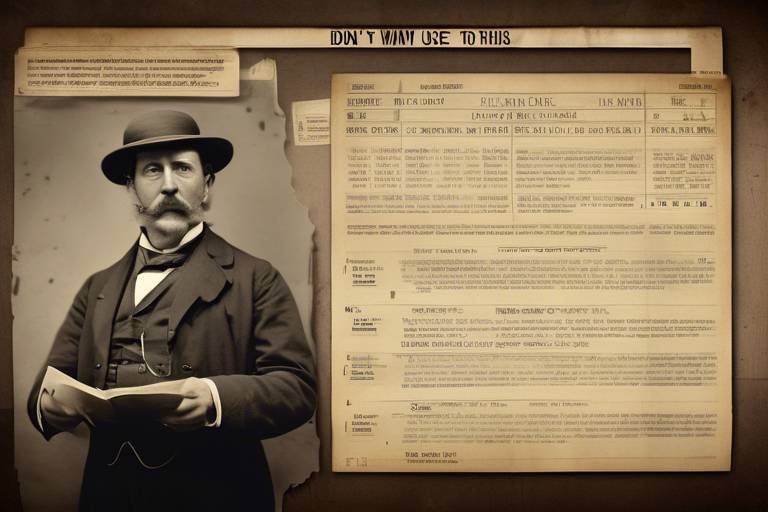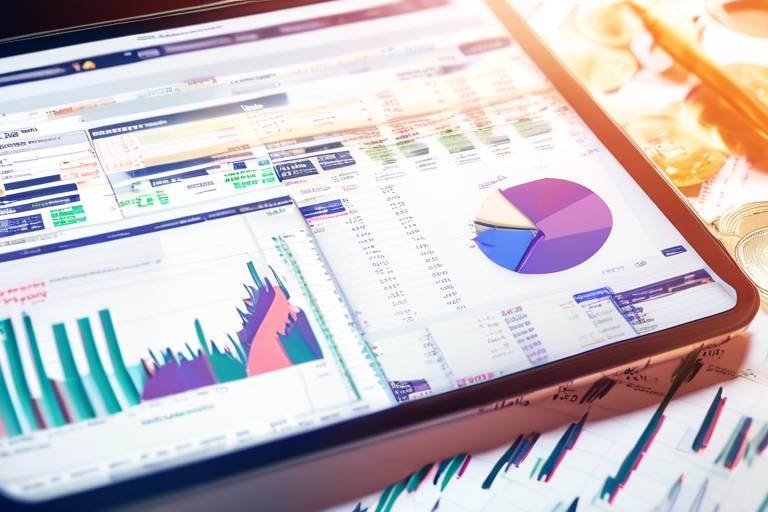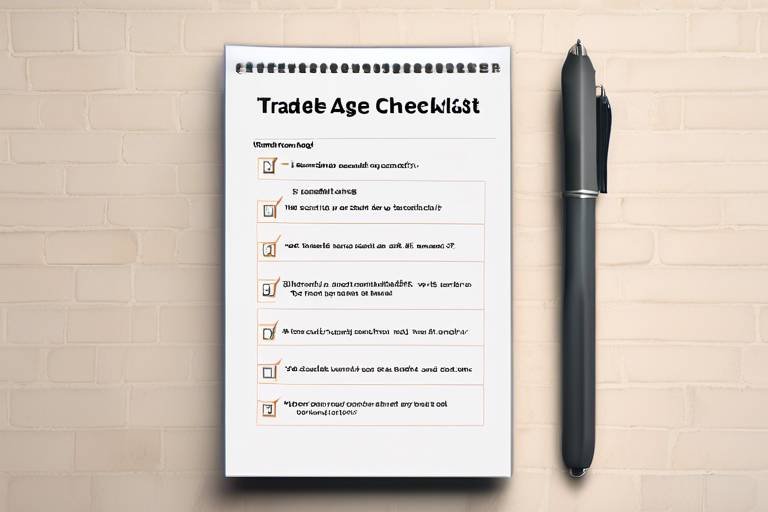Using Historical Data to Inform Your Trades
In the fast-paced world of trading, where every second counts and decisions can lead to significant financial outcomes, the importance of historical data cannot be overstated. Imagine you're a sailor navigating through uncharted waters; historical data serves as your compass, guiding you through the tumultuous waves of market fluctuations. This article delves into the significance of historical data in trading, offering insights into market trends, risk management, and strategies that can enhance decision-making for traders of all levels.
Understanding why historical data is crucial for traders can help in making informed decisions. It reveals patterns, trends, and potential future movements based on past market behavior. Just like a seasoned detective analyzing clues from a crime scene, traders can uncover valuable insights from the past. By examining historical data, traders can identify recurring trends that may indicate future price movements, allowing them to make more educated predictions. This not only enhances their trading strategies but also boosts their confidence in the decisions they make.
Various types of historical data exist, including price action, volume, and economic indicators. Each type provides unique insights that can be leveraged for better trading strategies. For instance, price action data gives traders a clear view of how prices have moved over time, while volume data reveals the strength behind those price movements. Economic indicators, on the other hand, provide a broader context of market conditions that can influence price trends. By synthesizing these different types of data, traders can develop a more comprehensive understanding of the market.
Price action analysis focuses on historical price movements, helping traders identify trends and reversals. This method emphasizes the importance of chart patterns and price levels in decision-making. Traders can often spot trends by looking at how prices have behaved in the past, much like an artist recognizing patterns in their brushstrokes. By analyzing these movements, traders can make strategic decisions about when to enter or exit the market.
Candlestick patterns are visual representations of price movements over time. Recognizing these patterns can provide traders with critical insights into market sentiment and potential price direction. For example, a series of bullish candlesticks may indicate growing investor confidence, while bearish patterns could suggest a downturn. Understanding these signals can be the difference between a successful trade and a costly mistake.
Identifying support and resistance levels based on historical data helps traders establish entry and exit points. These levels indicate where price reversals are likely to occur. Think of support as the floor of a room and resistance as the ceiling; prices tend to bounce off these levels. By knowing where these key levels lie, traders can make informed decisions about when to buy or sell, maximizing their potential profits.
Volume analysis examines the number of shares or contracts traded over a specific period. Understanding volume trends can provide insights into the strength of price movements and market sentiment. High trading volume often indicates strong interest in a particular asset, while low volume may suggest a lack of conviction among traders. By analyzing volume alongside price movements, traders can gain a clearer picture of market dynamics.
Economic indicators such as GDP, unemployment rates, and inflation affect market conditions. Analyzing these indicators alongside historical data can enhance trading strategies and risk assessment. For instance, if a country reports a rise in GDP, it may signal economic growth, leading to increased investor confidence and potentially higher asset prices. By staying informed about these indicators, traders can make more strategic decisions that align with broader economic trends.
Differentiating between leading and lagging indicators is essential for traders. Leading indicators predict future movements, while lagging indicators confirm trends, providing a balanced approach to trading decisions. Utilizing both types of indicators can help traders develop a more robust trading strategy, ensuring they are prepared for potential market shifts.
Backtesting involves applying trading strategies to historical data to evaluate their effectiveness. This process helps traders refine their approaches and gain confidence in their methods before live trading. By simulating trades based on past data, traders can identify what works and what doesn’t, allowing them to make adjustments before risking real capital. It's akin to a rehearsal before the big performance; the more prepared you are, the better your chances of success.
Effective risk management is vital for successful trading. Historical data allows traders to assess potential risks and develop strategies to mitigate losses while maximizing profits. By understanding past market behavior, traders can set realistic expectations and avoid emotional decision-making.
Using historical data to determine optimal stop-loss levels can protect traders from significant losses. Analyzing past price movements helps identify where to place stop-loss orders effectively. For instance, if a stock has consistently bounced off a certain level, placing a stop-loss just below that level can help minimize losses while allowing for potential gains.
Position sizing is crucial for managing risk. Historical data can help traders determine the appropriate size of their trades based on past performance and volatility. By calculating the potential risk of a trade relative to their overall portfolio, traders can make informed decisions that align with their risk tolerance.
- What is historical data in trading? Historical data refers to past market information, including price movements, volume, and economic indicators, that traders use to inform their decisions.
- How can I use historical data to improve my trading? By analyzing historical data, you can identify patterns, trends, and potential entry and exit points, enhancing your trading strategies.
- What are candlestick patterns? Candlestick patterns are visual representations of price movements that help traders gauge market sentiment and predict future price actions.
- Why is risk management important? Risk management is crucial because it helps traders limit losses and protect their capital, ensuring long-term success in trading.

The Importance of Historical Data
Understanding why historical data is crucial for traders can significantly enhance their decision-making process. Imagine trying to navigate a ship through stormy seas without a map or compass; that’s what trading without historical data feels like. Historical data acts as a lighthouse, illuminating the path by revealing patterns, trends, and potential future movements based on past market behavior.
One of the primary reasons traders rely on historical data is its ability to provide insights into market psychology. Markets are often driven by human emotions—fear, greed, and uncertainty. By analyzing how these emotions have influenced price movements in the past, traders can better predict how similar sentiments might affect the market in the future. This understanding can lead to more informed trading decisions, ultimately increasing the chances of success.
Moreover, historical data allows traders to identify market trends. For instance, by examining past price movements, traders can discern whether a particular asset is in a long-term uptrend or downtrend. This knowledge is invaluable, as it helps traders align their strategies with prevailing market conditions rather than against them. In essence, historical data serves as a guide, helping traders to ride the waves of market fluctuations rather than being tossed around by them.
Additionally, historical data plays a crucial role in risk management. It provides a framework for assessing potential risks associated with a trade. By analyzing how an asset has performed during various market conditions, traders can better understand the likelihood of adverse price movements. This understanding aids in developing robust risk management strategies, which are essential for long-term success in trading.
To illustrate the importance of historical data, consider the following table that summarizes key benefits:
| Benefit | Description |
|---|---|
| Identifying Trends | Helps traders recognize long-term market movements. |
| Understanding Market Psychology | Reveals how emotions have impacted past price actions. |
| Enhancing Risk Management | Provides insights into potential risks and volatility. |
| Informed Decision-Making | Equips traders with data-driven insights for better trades. |
In conclusion, the importance of historical data in trading cannot be overstated. It is the foundation upon which successful trading strategies are built. By leveraging historical data, traders can unveil the hidden stories behind market movements, make informed decisions, and ultimately enhance their trading performance.

Types of Historical Data
When diving into the vast ocean of trading, it's essential to understand the different types of historical data that can serve as your compass. Just like a seasoned sailor relies on various tools to navigate the unpredictable seas, traders utilize distinct data types to chart their course through the financial markets. Each type of historical data offers unique insights that can help traders make informed decisions, refine their strategies, and ultimately enhance their trading performance.
One of the primary forms of historical data is price action, which refers to the movement of a security's price over time. Analyzing price action allows traders to identify patterns and trends that can indicate potential future movements. For instance, the highs and lows of a stock's price can reveal critical support and resistance levels, guiding traders in their entry and exit points. It's like reading the waves of the ocean; the more you understand the patterns, the better you can predict where the tide will take you.
Another significant type of historical data is volume. Volume measures the number of shares or contracts traded during a specific period and can provide crucial insights into market sentiment. For example, a sudden spike in volume may suggest that a price movement is gaining strength, while low volume might indicate a lack of interest in a particular security. Understanding volume trends is akin to gauging the wind's strength; it can tell you whether to set sail or stay anchored.
Additionally, traders often look at economic indicators as a vital source of historical data. These indicators, which include metrics like GDP growth, unemployment rates, and inflation, can significantly influence market conditions. By analyzing these factors alongside historical price and volume data, traders can develop a more comprehensive understanding of the market landscape. For instance, high unemployment rates may lead to decreased consumer spending, which can impact the stock market's overall performance. It's like keeping an eye on the weather forecast before planning a trip; knowing the economic climate can help you prepare for what's ahead.
In summary, understanding the various types of historical data—price action, volume, and economic indicators—can empower traders to make more informed decisions. By leveraging these insights, traders can better navigate the complexities of the market and enhance their trading strategies. Remember, the more data you have at your disposal, the clearer your trading vision becomes.

Price Action Analysis
Price action analysis is a powerful tool that traders use to make sense of the market's historical price movements. Imagine you’re a detective, piecing together clues from the past to predict what might happen next. By focusing solely on price movements, traders can identify trends, reversals, and potential entry and exit points without relying on external indicators. This method emphasizes the importance of chart patterns and price levels, turning historical data into a roadmap for future trades.
One of the key elements of price action analysis is the recognition of candlestick patterns. These patterns are visual representations of price movements over specific time frames, and they can tell a story about market sentiment. For example, a series of bullish candlesticks may indicate strong buying interest, while bearish candlesticks could suggest selling pressure. Traders who can read these patterns effectively can gain critical insights into potential price direction.
Moreover, understanding support and resistance levels is crucial in price action analysis. These levels are determined by historical data, indicating where price reversals are likely to occur. Support levels act as a safety net, preventing prices from falling further, while resistance levels serve as a ceiling, stopping prices from rising beyond a certain point. By identifying these levels on a chart, traders can establish strategic entry and exit points, increasing their chances of making profitable trades.
To illustrate this concept, consider the following table that outlines common candlestick patterns and their implications:
| Candlestick Pattern | Implication |
|---|---|
| Hammer | Potential bullish reversal after a downtrend |
| Engulfing Pattern | Strong reversal signal; bullish if it follows a downtrend, bearish if it follows an uptrend |
| Doji | Indecision in the market; potential reversal |
| Morning Star | Bullish reversal pattern after a downtrend |
| Evening Star | Bearish reversal pattern after an uptrend |
In conclusion, price action analysis is not just about looking at numbers; it's about understanding the story those numbers tell. By mastering this technique, traders can enhance their decision-making processes, allowing them to navigate the complexities of the market with greater confidence. So, the next time you sit down to analyze a chart, remember that the past is your guide, and the price action is the narrative that can lead you to success.
- What is price action analysis?
Price action analysis involves studying historical price movements to identify trends and make trading decisions without relying on indicators. - How can I identify support and resistance levels?
Support and resistance levels can be identified by looking at historical price points where the price has repeatedly bounced off or failed to break through. - What are candlestick patterns?
Candlestick patterns are formations created by the open, high, low, and close prices of a security over a specific time period, indicating market sentiment. - Can beginners use price action analysis?
Absolutely! Price action analysis can be a great starting point for beginners as it focuses on the fundamentals of price movement.

Candlestick Patterns
Candlestick patterns are not just random squiggles on a chart; they are powerful visual tools that convey essential information about market sentiment and price action. Each candlestick represents a specific time period and provides four vital data points: the open, high, low, and close prices. By analyzing these patterns, traders can gain insights into the emotional state of the market, helping them make informed decisions about when to enter or exit a trade.
One of the most fascinating aspects of candlestick patterns is their ability to illustrate the battle between buyers and sellers. For instance, a long green (or bullish) candlestick indicates that buyers were in control during that period, pushing the price significantly higher. Conversely, a long red (or bearish) candlestick suggests that sellers dominated, driving the price down. Recognizing these patterns can help traders anticipate potential reversals or continuations in price movement.
There are numerous candlestick patterns that traders should familiarize themselves with, but some of the most significant include:
- Doji: This pattern occurs when the opening and closing prices are nearly the same, indicating indecision in the market.
- Hammer: A hammer candlestick has a small body and a long lower shadow, suggesting a potential bullish reversal after a downtrend.
- Engulfing Pattern: This pattern consists of two candlesticks, where the second candlestick completely engulfs the body of the first, indicating a strong reversal signal.
Understanding the context in which these patterns appear is crucial. For example, a hammer pattern found at the bottom of a downtrend may signal a reversal, while the same pattern in a strong uptrend may not carry the same weight. Therefore, traders often combine candlestick analysis with other technical indicators to confirm their findings.
Moreover, the psychology behind candlestick patterns is equally compelling. They tell a story of market dynamics, where fear and greed play significant roles. By interpreting these patterns, traders can gain a deeper understanding of market sentiment, allowing them to make more strategic trading decisions.
In summary, mastering candlestick patterns is an essential skill for traders looking to enhance their trading strategies. By paying close attention to these visual cues, traders can better navigate the complexities of the market and increase their chances of success.
What are candlestick patterns?
Candlestick patterns are visual representations of price movements over time, providing insights into market sentiment and potential price direction.
How do I use candlestick patterns in trading?
Traders use candlestick patterns to identify potential reversals or continuations in price movement, often combining them with other indicators for confirmation.
Can candlestick patterns guarantee successful trades?
No trading method can guarantee success, but understanding candlestick patterns can significantly improve decision-making and risk management.

Support and Resistance Levels
Support and resistance levels are fundamental concepts in trading that can significantly influence your decision-making process. Understanding these levels is like having a map in a foreign city; it helps you navigate the unpredictable terrain of the market. Support levels act as a safety net where prices tend to stop falling and may even bounce back, while resistance levels are like ceilings that prices struggle to break through. Identifying these levels is crucial for traders, as they can indicate potential entry and exit points.
When traders look at historical data, they often notice that certain price levels have repeatedly acted as support or resistance. For example, if a stock has bounced off a specific price point multiple times in the past, that price can be considered a strong support level. Conversely, if the same stock has struggled to rise above a certain price, that price may be deemed a resistance level. This repetitive behavior creates a sense of predictability, allowing traders to make more informed decisions.
Moreover, the psychology of market participants plays a significant role in the effectiveness of support and resistance levels. Many traders watch these levels closely, leading to a self-fulfilling prophecy—when enough traders believe a price will bounce off a support level, they buy, causing the price to rise. Similarly, if traders expect a price to hit a resistance level and then drop, they may sell, leading to a decline in price. This collective behavior can amplify the impact of these levels, making them even more critical for traders to monitor.
To visualize the importance of support and resistance levels, consider the following table that outlines how these levels can be determined:
| Method | Description |
|---|---|
| Historical Price Points | Identifying previous highs and lows in price charts. |
| Moving Averages | Using averages to smooth out price data and identify potential support/resistance. |
| Trend Lines | Drawing lines that connect price points to determine upward or downward trends. |
In practice, traders often combine these methods to create a more comprehensive view of potential support and resistance levels. For instance, if a historical price point aligns with a moving average and a trend line, it may indicate a stronger level of support or resistance. This multi-faceted approach can enhance the reliability of your trading strategies.
In summary, understanding support and resistance levels is essential for any trader looking to navigate the complexities of the market. By incorporating historical data and recognizing the psychological aspects of trading, you can better position yourself for success. Remember, the market is a living entity that reacts to the actions of its participants, and knowing where these pivotal levels lie can give you a significant edge.
- What are support and resistance levels? Support levels are price points where a stock tends to stop falling, while resistance levels are points where it struggles to rise above.
- How can I identify these levels? You can identify support and resistance levels by analyzing historical price points, using moving averages, and drawing trend lines.
- Why are these levels important? They help traders make informed decisions about when to enter or exit trades, reducing risks and increasing potential profits.
- Can support and resistance levels change over time? Yes, as market conditions change and new data becomes available, support and resistance levels can shift, necessitating ongoing analysis.

Volume Analysis
When it comes to trading, is like the heartbeat of the market. It tells you how many shares or contracts are being traded over a specific period, and understanding this can be the key to unlocking the mysteries of price movements. Just as a doctor checks your pulse to gauge your health, traders analyze volume to assess market strength and sentiment. High volume can indicate that a trend is strong and likely to continue, while low volume can suggest a lack of interest, which might signal a reversal or a weakening trend.
But how do you interpret this data effectively? Let's break it down. Volume can be analyzed in conjunction with price movements to provide insights into market dynamics. For example, if a stock's price rises significantly but the volume is low, it might be a red flag, suggesting that the rally lacks support from traders. Conversely, if the price rises alongside high volume, it typically indicates strong buying interest, which can be a bullish signal.
Here are some key points to consider when conducting volume analysis:
- Volume Spikes: Sudden increases in volume can indicate a significant event or news affecting the stock, prompting traders to take notice. These spikes can often precede major price movements.
- Volume Trends: Observing volume trends over time can help identify whether a trend is gaining momentum or losing steam. A consistent increase in volume as prices rise is generally a positive sign.
- Volume and Price Divergence: When price moves in one direction while volume moves in the opposite direction, it can signal a potential reversal. For instance, if prices are climbing but volume is declining, it might suggest that the rally is losing strength.
To make volume analysis even more effective, traders often combine it with other indicators, such as moving averages or the Relative Strength Index (RSI). This multi-faceted approach can provide a more comprehensive view of market conditions, allowing traders to make more informed decisions. For instance, a trader might look for a scenario where a stock is approaching a resistance level, with increasing volume, and also showing an overbought condition on the RSI. This convergence of signals could suggest a potential breakout or reversal.
In summary, volume analysis is an indispensable tool in a trader's arsenal. It helps to confirm price movements, gauge market sentiment, and ultimately informs better trading decisions. Just like a detective piecing together clues, understanding volume can lead to more successful trading outcomes and a deeper comprehension of market behavior.
Q1: What is the significance of volume in trading?
A1: Volume is significant because it indicates the strength of price movements. High volume suggests strong interest and conviction in a price move, while low volume can indicate weakness or indecision.
Q2: How can I use volume to improve my trading strategy?
A2: You can use volume to confirm trends, identify potential reversals, and gauge market sentiment. By analyzing volume alongside price movements, you can make more informed trading decisions.
Q3: What should I do if I see a volume spike?
A3: A volume spike can indicate an important event or shift in market sentiment. It's essential to investigate the cause of the spike and consider how it may affect price movements before making any trading decisions.

Utilizing Economic Indicators
When it comes to trading, understanding the broader economic landscape is just as crucial as analyzing historical price data. Economic indicators serve as the pulse of the economy, providing traders with insights that can significantly impact market movements. These indicators can be broadly classified into two categories: leading indicators and lagging indicators. Leading indicators, such as consumer sentiment and building permits, forecast future economic activity, while lagging indicators, like unemployment rates and GDP growth, confirm trends after they have occurred.
By incorporating economic indicators into your trading strategy, you can enhance your decision-making process. For instance, if you notice a rise in consumer confidence, it may signal an increase in consumer spending, which could positively affect stock prices in retail sectors. On the flip side, a spike in unemployment rates might indicate a slowing economy, leading to bearish sentiments in the market. This interplay between economic indicators and historical data can help traders anticipate market movements more accurately.
Let’s take a closer look at some key economic indicators that traders should monitor:
- Gross Domestic Product (GDP): This measures the total economic output of a country. A growing GDP typically correlates with a healthy economy and rising stock prices.
- Unemployment Rate: High unemployment can lead to decreased consumer spending, negatively impacting economic growth and stock prices.
- Inflation Rate: Moderate inflation is generally seen as a sign of a growing economy, but high inflation can erode purchasing power and lead to tighter monetary policy.
- Interest Rates: Central banks adjust interest rates to control inflation and stabilize the economy. Lower rates can stimulate borrowing and spending, while higher rates can slow economic growth.
Integrating these indicators with historical data creates a comprehensive view of market conditions. For example, if historical data shows that a particular stock tends to rise during periods of low unemployment, and you notice a downward trend in unemployment rates, it might be a good time to consider buying that stock. Conversely, if historical patterns reveal that a spike in inflation often leads to a downturn in the market, you may want to adopt a more cautious trading approach.
Moreover, traders can use economic calendars to keep track of when these indicators are released. By being proactive and aware of upcoming reports, you can position yourself to react swiftly to market changes. The key is to remain flexible and adjust your trading strategies as new data becomes available.
In conclusion, utilizing economic indicators alongside historical data is essential for traders seeking to enhance their trading strategies. By understanding the relationship between economic conditions and market movements, traders can make more informed decisions, ultimately leading to greater success in the trading arena.
Q: What are economic indicators?
A: Economic indicators are statistics that provide insight into the economic performance of a country. They help traders gauge the health of the economy and make informed trading decisions.
Q: How do leading and lagging indicators differ?
A: Leading indicators predict future economic activity, while lagging indicators confirm trends after they have occurred. Both types are valuable for traders but serve different purposes.
Q: Why should traders pay attention to economic indicators?
A: Economic indicators help traders understand the broader market environment, allowing them to anticipate potential price movements and adjust their strategies accordingly.

Leading vs. Lagging Indicators
When it comes to making informed trading decisions, understanding the difference between leading and lagging indicators is crucial. Think of leading indicators as your forward-looking compass, guiding you toward potential future market movements. They are designed to predict where the market is headed, giving traders an edge by signaling upcoming trends before they fully materialize. On the other hand, lagging indicators act like a rearview mirror, confirming trends that have already occurred. They are essential for validating the direction you might want to take based on historical price movements.
Let’s dive deeper into what each type of indicator entails:
| Indicator Type | Description | Examples |
|---|---|---|
| Leading Indicators | Predict future price movements and trends. | Relative Strength Index (RSI), Moving Average Convergence Divergence (MACD) |
| Lagging Indicators | Confirm trends and movements that have already happened. | Moving Averages, Bollinger Bands |
Leading indicators, such as the Relative Strength Index (RSI), can alert traders to potential reversals or continuations in price action before they happen. For instance, if the RSI indicates that an asset is overbought, it may suggest that a price correction is imminent. Conversely, lagging indicators like Moving Averages help traders confirm whether a trend is still in play or fading away. For example, if the price remains above a moving average, it often indicates a bullish trend.
Both types of indicators have their place in a trader's toolkit. Relying solely on leading indicators might lead to premature decisions, while only using lagging indicators could mean missing out on profitable opportunities. The best approach is to use a combination of both to create a balanced trading strategy. By integrating leading indicators to anticipate movements and lagging indicators to confirm trends, traders can enhance their decision-making process significantly.
In essence, understanding the interplay between leading and lagging indicators allows traders to develop a comprehensive view of the market. It’s like having a two-way street; one side shows you where you might be headed, while the other confirms where you’ve just been. This dual approach can provide a more robust framework for making trading decisions, ultimately leading to better outcomes.
- What are leading indicators? Leading indicators are tools that predict future price movements in the market.
- What are lagging indicators? Lagging indicators are metrics that confirm trends that have already occurred.
- Can I use both indicators in my trading strategy? Absolutely! Using both leading and lagging indicators can provide a more comprehensive view of market conditions.
- How do I choose which indicators to use? The choice of indicators depends on your trading style and the specific market conditions you are analyzing.

Backtesting Trading Strategies
Backtesting is a critical component in the toolkit of any serious trader. It involves applying a trading strategy to historical data to assess its viability before risking real money in the market. Think of it as a dress rehearsal before the big performance. Just as actors rehearse their lines and block out scenes, traders must test their strategies against past market conditions. This process not only helps in refining the approach but also builds confidence in the trader's methodology.
When backtesting, traders are essentially trying to answer a pivotal question: "Would this strategy have worked in the past?" This inquiry is essential because the past often provides invaluable insights into future market behavior. By simulating trades based on historical data, traders can see how their strategies would have performed, identifying strengths and weaknesses along the way. For instance, a strategy that looks promising on paper might fail during certain market conditions, which only becomes evident through backtesting.
There are several key elements to consider when backtesting trading strategies:
- Data Quality: The accuracy and completeness of historical data are paramount. Inaccurate data can lead to misleading results, so it’s crucial to source high-quality data from reliable providers.
- Time Frame: The choice of time frame for backtesting can significantly affect the outcomes. Short-term strategies may require minute-by-minute data, while long-term strategies may only need daily or weekly data.
- Transaction Costs: Incorporating transaction costs, such as commissions and slippage, into the backtesting model is vital. These costs can erode profits and should be factored into the performance metrics.
Moreover, backtesting is not just about running numbers; it's also about understanding the market dynamics. Traders should analyze how external factors, such as economic news or geopolitical events, might have influenced market movements during the backtest period. This understanding can provide context that raw data alone cannot offer.
Once the backtesting is complete, traders can evaluate the results using various performance metrics. Common metrics include:
| Metric | Description |
|---|---|
| Win Rate | The percentage of trades that were profitable. |
| Risk-to-Reward Ratio | A measure comparing the potential profit of a trade to its potential loss. |
| Maximum Drawdown | The largest peak-to-trough decline in the account balance during the backtest. |
In conclusion, backtesting trading strategies is not just a luxury; it's a necessity for traders who wish to make informed decisions based on historical performance. By rigorously testing strategies against past data, traders can enhance their decision-making processes, reduce risks, and ultimately improve their chances of success in the ever-evolving market landscape.
What is backtesting in trading?
Backtesting is the process of applying a trading strategy to historical data to evaluate its effectiveness before using it in live trading.
Why is backtesting important?
Backtesting helps traders identify the strengths and weaknesses of their strategies, allowing them to refine their approach and gain confidence before risking real capital.
How do I ensure the accuracy of my backtesting?
To ensure accuracy, use high-quality historical data, consider transaction costs, and analyze the market conditions during the backtest period.
What metrics should I use to evaluate backtesting results?
Common metrics include win rate, risk-to-reward ratio, and maximum drawdown, which provide insights into the strategy's performance.

Risk Management with Historical Data
Effective risk management is the backbone of successful trading, and utilizing historical data is one of the most potent tools in a trader's arsenal. By analyzing past market behavior, traders can identify potential risks and develop strategies that not only mitigate losses but also enhance profitability. Think of historical data as a treasure map; it provides clues about where to tread carefully and where opportunities might lie. The more you understand the landscape of past market movements, the better equipped you are to navigate the often-turbulent waters of trading.
One of the primary ways traders can leverage historical data is by setting stop-loss orders. These orders are essential for protecting against significant losses, and historical data plays a crucial role in determining their optimal placement. By analyzing previous price movements, traders can identify levels where the price has historically reversed. For instance, if a stock has consistently bounced back at a certain price point, placing a stop-loss just below that level can be a wise decision. This strategy allows traders to limit their losses while giving their trades room to breathe.
To illustrate this concept, consider the following table that summarizes the importance of historical data in setting stop-loss orders:
| Price Level | Historical Behavior | Suggested Stop-Loss Placement |
|---|---|---|
| $50 | Price has bounced back 3 times | $49.50 |
| $30 | Price has reversed twice | $29.50 |
| $70 | Price has shown strong resistance | $69.00 |
Another critical aspect of risk management is position sizing. This concept revolves around determining the appropriate size of a trader's positions based on historical performance and market volatility. By analyzing how much a particular asset has fluctuated in the past, traders can better gauge how much risk they are willing to take on. For example, if a trader notices that a stock has a history of volatile swings, they might choose to reduce their position size to avoid excessive risk. Conversely, a more stable asset may allow for larger positions.
Incorporating historical data into position sizing can be likened to adjusting your sails based on the wind. If the winds of volatility are strong, you may want to trim your sails to maintain control; if the seas are calm, you can open them up and take a bigger risk. By doing so, traders can protect their capital while still participating in potential gains.
In summary, historical data serves as a vital resource for traders looking to implement effective risk management strategies. By analyzing past price movements and market behaviors, traders can make informed decisions regarding stop-loss placements and position sizing. This not only helps in safeguarding their investments but also in maximizing their potential profits. As the saying goes, "Those who cannot remember the past are condemned to repeat it." In trading, this couldn't be more accurate. Understanding historical data empowers traders to navigate the future with more confidence and clarity.
- What is the role of historical data in trading? Historical data helps traders identify patterns and trends that can inform their trading decisions.
- How can I use historical data for risk management? Traders can analyze past price movements to set stop-loss orders and determine appropriate position sizes.
- What types of historical data should I focus on? Key types include price action, volume, and economic indicators, all of which provide unique insights.
- Can historical data guarantee future success? While it cannot guarantee success, it significantly enhances decision-making by providing context and insights.

Setting Stop-Loss Orders
Setting stop-loss orders is a fundamental aspect of trading that can significantly impact a trader's success. Think of a stop-loss order as a safety net; it’s designed to limit your losses on a trade by automatically selling your position when the price reaches a predetermined level. This strategy is particularly vital in the volatile world of trading, where prices can swing dramatically in a matter of moments. Without a stop-loss, you risk watching your investment dwindle away, which can be both stressful and financially devastating.
When it comes to determining the optimal level for your stop-loss order, historical data plays a crucial role. By analyzing past price movements, traders can identify key support and resistance levels that can guide where to place their stop-loss orders. For instance, if historical data shows that a stock tends to bounce back at a certain price point, placing your stop-loss just below that level could be a wise decision. This way, you allow for minor fluctuations in price while still protecting yourself from larger downturns.
Additionally, it’s essential to consider the volatility of the asset you are trading. Highly volatile stocks may require wider stop-loss levels to avoid being triggered by normal price fluctuations. Conversely, for more stable stocks, a tighter stop-loss may be appropriate. Here’s a simple breakdown of how to set your stop-loss based on volatility:
| Volatility Level | Recommended Stop-Loss Distance |
|---|---|
| High | 5-10% below entry price |
| Medium | 3-5% below entry price |
| Low | 1-3% below entry price |
Another factor to consider is your overall trading strategy. Are you a day trader aiming for quick profits, or are you a long-term investor looking to ride out the waves? Your approach will dictate how you set your stop-loss orders. For example, day traders might use tighter stop-losses to protect their capital from sudden market shifts, while long-term investors may opt for a more lenient approach, allowing their investments more room to breathe.
Ultimately, the goal of setting stop-loss orders is to create a balanced risk-reward ratio. It’s about finding that sweet spot where you feel comfortable with your potential losses while still allowing for the possibility of gains. Remember, trading without a stop-loss is like sailing without a life jacket; it’s risky, and you never know when the waters might turn rough. By using historical data to inform your stop-loss placement, you can navigate the turbulent seas of trading with greater confidence and security.
- What is a stop-loss order? A stop-loss order is a type of order designed to limit an investor's loss on a position in a security.
- How do I determine where to set my stop-loss? Analyze historical price movements, support and resistance levels, and consider the volatility of the asset.
- Can I adjust my stop-loss order after it’s been set? Yes, you can adjust your stop-loss order at any time based on market conditions and your trading strategy.
- What happens if my stop-loss order is triggered? If your stop-loss order is triggered, your position will automatically be sold at the market price to limit your losses.

Position Sizing Techniques
When it comes to trading, one of the most critical aspects that often gets overlooked is position sizing. Think of it as the foundation of your trading house; without a solid base, everything else can crumble. Position sizing involves determining how much of your capital you should allocate to a particular trade, and getting this right can mean the difference between long-term success and blowing your account. So, how do you figure out the best position size for your trades? Let’s dive into some techniques that can help you make informed decisions.
First and foremost, you need to understand your risk tolerance. This is a personal metric that varies from trader to trader, depending on factors like your financial situation, trading experience, and psychological comfort with risk. A common rule of thumb is to risk no more than 1-2% of your trading capital on a single trade. For example, if you have a trading account with $10,000, risking 1% means you would only risk $100 on any given trade. This approach helps you stay in the game longer, even if you hit a rough patch.
Next, let’s talk about the risk-reward ratio. This is a key concept that helps you evaluate whether a trade is worth taking. A good rule of thumb is to aim for a risk-reward ratio of at least 1:2. This means for every dollar you risk, you should aim to make at least two dollars. To illustrate this, let’s say you’re considering a trade where you plan to enter at $50, set a stop-loss at $48 (risking $2), and set a target price at $54 (potential gain of $4). Here, your risk-reward ratio is 1:2, which is favorable. This way, even if you only win half of your trades, you can still come out ahead.
Another technique involves using the Kelly Criterion, a formula that helps determine the optimal size of your bets based on your win rate and the ratio of your average win to your average loss. While it can get a bit complicated, the basic idea is to allocate a portion of your capital proportional to your edge in the market. This method can be particularly useful for traders who have a good grasp of their winning percentages and the average returns they can expect.
Finally, consider implementing a position sizing calculator. There are various online tools available that can help you determine the appropriate position size based on your account balance, risk percentage, and stop-loss distance. Utilizing such tools can take the guesswork out of the equation, allowing you to focus more on your trading strategy. Here's a simple example of how a position sizing calculator might work:
| Account Balance | Risk Percentage | Stop-Loss Distance | Position Size |
|---|---|---|---|
| $10,000 | 1% | $2 | 50 shares |
In this example, if you risk 1% of your $10,000 account, that’s $100. If your stop-loss is set at $2, the calculator would suggest you buy 50 shares (since $100 divided by $2 equals 50). This method not only makes your trading more systematic but also helps in maintaining discipline, which is crucial for long-term success.
In summary, mastering position sizing techniques is essential for any trader looking to enhance their trading strategy. By understanding your risk tolerance, applying the risk-reward ratio, considering advanced methods like the Kelly Criterion, and leveraging position sizing calculators, you can make more informed decisions that align with your trading goals. Remember, it’s not just about how much you make, but how much you risk to get there!
- What is the best position size for a trade? The best position size varies based on your risk tolerance and the specifics of each trade. A common guideline is to risk no more than 1-2% of your capital on a single trade.
- How do I calculate my risk-reward ratio? Divide the potential profit of the trade by the potential loss. A ratio of 1:2 is generally considered favorable.
- What is the Kelly Criterion? It’s a formula used to determine the optimal size of your bets based on your win rate and the average returns of your trades.
- Are position sizing calculators helpful? Yes, they can simplify the process and help you maintain discipline in your trading strategy.
Frequently Asked Questions
- Why is historical data important for trading?
Historical data is like a treasure map for traders. It reveals patterns and trends that can help predict future market movements. By analyzing past price actions and economic indicators, traders can make informed decisions, manage risks better, and enhance their strategies.
- What types of historical data should I focus on?
There are several types of historical data you can explore, including price action, volume, and economic indicators. Each type offers unique insights. For example, price action helps identify trends, while volume analysis reveals the strength behind price movements. Economic indicators, on the other hand, provide context about the broader market environment.
- How can I use candlestick patterns in trading?
Candlestick patterns are visual cues that tell a story about market sentiment. By recognizing these patterns, traders can anticipate potential price movements. For instance, a bullish engulfing pattern might signal a reversal, indicating it’s time to buy, while a bearish pattern could suggest selling.
- What are support and resistance levels?
Support and resistance levels are critical price points where the market tends to reverse direction. Support is a price level where buying interest is strong enough to prevent the price from falling further, while resistance is where selling interest can stop the price from rising. Identifying these levels can help traders decide when to enter or exit trades.
- How does volume analysis aid trading decisions?
Volume analysis allows traders to gauge the strength of price movements. If a price increase is accompanied by high volume, it suggests strong buying interest, making the move more reliable. Conversely, if prices rise on low volume, it could indicate a lack of conviction in the move, prompting traders to be cautious.
- What are leading and lagging indicators?
Leading indicators are like crystal balls, predicting future market movements based on current data, while lagging indicators confirm trends after they’ve occurred. Using both types in conjunction can provide a balanced approach to making trading decisions, helping traders stay ahead of the curve.
- What is backtesting and why is it important?
Backtesting involves applying trading strategies to historical data to see how they would have performed in the past. It’s essential because it allows traders to refine their strategies and build confidence before risking real money in live trading. Think of it as a rehearsal before the big performance!
- How can historical data improve risk management?
Historical data is a trader's best friend when it comes to risk management. By analyzing past price movements, traders can set optimal stop-loss orders and determine appropriate position sizes. This proactive approach helps mitigate potential losses while maximizing profits, ensuring a smoother trading experience.
- What are stop-loss orders and how should I set them?
A stop-loss order is like a safety net for traders. It automatically sells a security when it reaches a certain price, limiting potential losses. By using historical data to identify key price levels, traders can set their stop-loss orders effectively, protecting themselves from significant downturns.
- How can I determine the right position size for my trades?
Position sizing is crucial for managing risk. Historical data can help you assess the volatility of a security and past performance, guiding you in determining how much to invest in each trade. This way, you can ensure you’re not overexposing your capital while still taking advantage of potential opportunities.



















